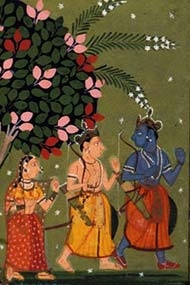Five Epic Works of Asian Literature, Illustrated and Reinterpreted

The Art of Storytelling: Five Tales from Asia, Then and Now
September 8–December 13, 2015
For immediate release: 8/25/15
For further information contact: Sarah Laursen, Youngman Curator of Asian Art, at slaursen@middlebury.edu or (802) 443-5491
Middlebury, VT—For as long as stories have been told, they have also been illustrated. Although technical advances such as printing and the advent of the computer have transformed illustration over time, many important artistic techniques and conventions have remained unchanged, even today. The Art of Storytelling compares the ways in which artists over the last five hundred years have retold and reinterpreted five epic works of Asian literature: the Mahabharata and Ramayana from India, Shahnameh from Iran, Journey to the West from China, and Tale of Genji from Japan.
The traditional paintings, woodblock prints, and books in this exhibition have been drawn from the collections of the Middlebury College Museum of Art, as well as the Harvard Art Museums, the Hood Museum of Art at Dartmouth, and Harvard-Yenching Library. Paired with the historical works are five contemporary retellings, all created in the last ten years by Asian and Asian-American comic book artists, graphic designers, illustrators, and animators. The last section of the exhibition is an interactive space in which visitors can create and display their own comics.
The first two stories in the exhibition focus on avatars, or earthly incarnations, of the Hindu god Vishnu. The Mahabharata revolves around Vishnu’s avatar Krishna, who served as charioteer and advisor to the warrior Arjuna during a great war between family members over the right to rule. A seventeenth century Mewari painting highlights Krishna’s mischievous nature and idyllic childhood, while pages from Abhishek Singh’s comic book Krishna: A Journey Within (2012) describe Krishna’s role in encouraging Arjuna to fulfill his duty by fighting in the war.
The Ramayana instead focuses on Vishnu’s avatar Rama, who must rescue his wife Sita when she is kidnapped by the demon king Ravanna. With the help of his brother Lakshman and the monkeys and bears of the forest, Rama finds his beloved and fights to gain her freedom. Eighteenth century Indian paintings and a rubbing of the stone relief décor on a Thai temple are complemented by illustrations from Pixar animator Sanjay Patel’s Ramayana: Divine Loophole (2010), whose playful characters evoke mid-century American graphic design.
Turning to Iran, the Shahnameh chronicles the lives and adventures of the pre-Islamic Persian kings and their trusted advisors, including the great Rostam. Accompanying Safavid (1501–1736) and late Mughal (1526–1857) manuscript folios are original compositions by graphic artist and filmmaker Hamid Rahmanian, who created his monumental Shahnameh: The Epic of Persian Kings (2013) by scanning and reconfiguring miniature paintings from across India, Central Asia, and the Middle East using Photoshop.
In contrast to the Shahnameh’s documentary tone, Journey to the West—Xiyouji in Chinese—is a popular novel recounting the monk Xuanzang’s journey to India to retrieve Buddhist scriptures. Along the way, he is accompanied by three other characters, most notably the monkey king Sun Wukong. This Chinese story is beloved throughout East Asia and was widely published in illustrated volumes in China and Japan. Early printed books and a nineteenth century woodblock print from Japan are presented alongside pages from American Born Chinese (2006) by educator and graphic novelist Gene Luen Yang. Yang intersperses the story of the monkey king with a coming-of-age tale about a boy named Jin who struggles to fit in as one of the only Asian-Americans at his new school.
Finally, Japan’s Tale of Genji gives an intimate view of life at the Heian (794–1185) court through an account of the romantic dalliances of an aristocrat named Genji. Written by an eleventh century female courtier, this story is represented in the exhibition by Edo period (1603–1868) printed and hand-colored books, a woodblock print, a painted handscroll, and a gilded folding screen. Mirroring the opulence of the works are dreamlike images from The Tale of Genji (2006) by designer and fine artist Yoshitaka Amano.
After viewing the illustrations in the exhibition, visitors are invited to the Studio, where they will find explanations of artists’ processes, as well as preparatory drawings made by some of the contemporary artists in the exhibition and by the eighteenth century Indian Kota Master. A drawing table and materials for making comics allow visitors to become illustrators themselves.
